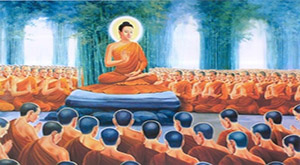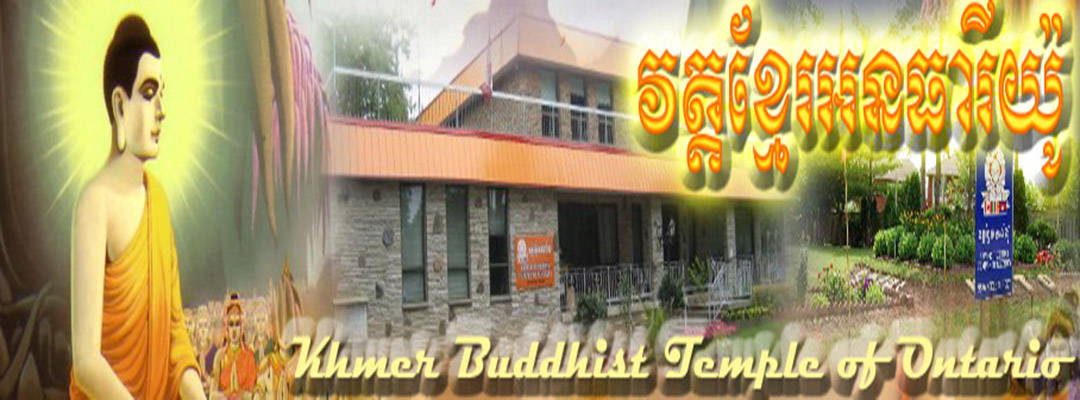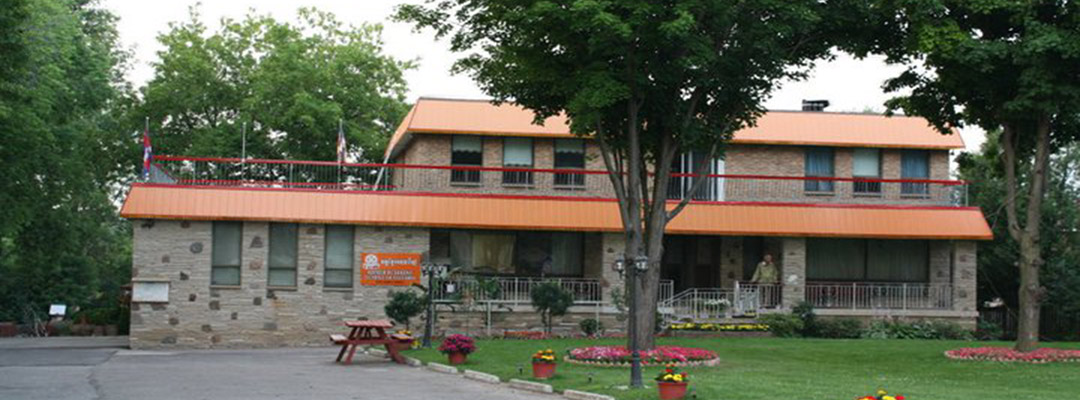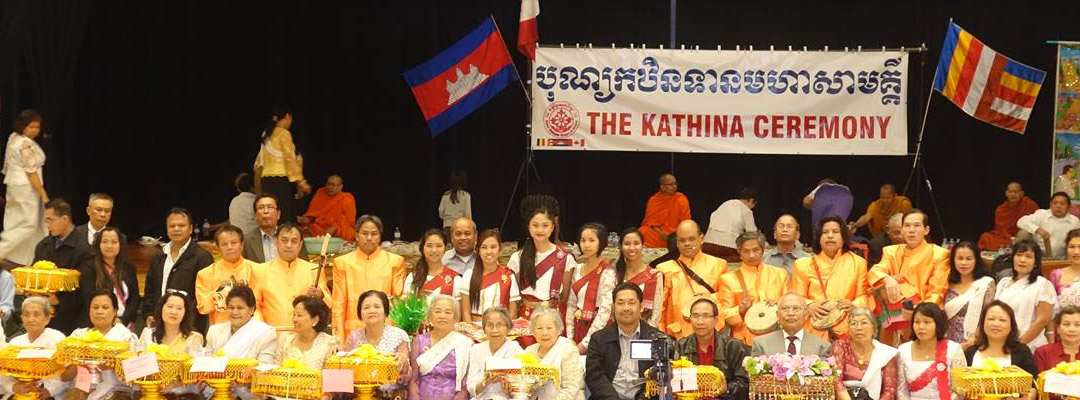
MAGHA PUJA DAY
Magha Puja Day falls on the full moon day of the second or third lunar month(late February or early March). The date of all of the Cambodian festivals is based on the lunar calendar so the "Canadian" dates vary from year to year.
In the Morning
(Date to be determined): Paying respect to the Triple Gem; Undertaking the Five Precepts; Dhamma Preaching given by monk on Magha Puja; Offering the lunch for monks and get blessed.In the Evening
(Date to be determined): Paying respect to the Triple Gem; Undertaking the Five Precepts, the monks chant Paritta, monks and laypeople perform the Magha Puja rite, offer the fragrant material offerings and recite the Magha Verses for homage to the Buddha.
This ceremony marks two important dates in the life of Buddha. The first event occurred two years after Buddha's enlightenment and is referred to as the Fourfold assembly. These events were:
- All 1,250 monks had achieved enlightenment.
- These monks were ordained by Buddha himself.
- The monks assembled on their own without being called together.
- It was a perfect full-moon day.
All of these occurred on full moon day of the third lunar month. As part of this gathering Buddha gave the basic principles of Buddhism to the monks, called the 'Ovadapatimokha' in the afternoon of Magha Puja day, at the grand temple Veluvana (Bamboo Grove) in the city of Rajgaha. These principles are:
- Not to do any bad deeds
- To do good deeds
- To cleanse the mind of impurities
If everyone followed these principles we would have a peaceful family, peaceful community, peaceful nation, and peaceful world. Or put another way, we would have peaceful and happy lives. The second event occurred in the second half of Buddha's life on Magha Puja Day. The Buddha delivered a sermon called "Keys for success". The second event was three months prior to his passing away and it's also said that on the same day of giving sermon called "Keys for success", the Buddha declared that he would pass away in three months time. During this ceremony lay people focus more intensely on Dhamma and meditation. Dhamma (or Dharma) as it is sometimes referred to is the teachings of Buddha. Lay people would typically take vows to refrain from bad habits and perform acts to benefit them spiritually. The Keys are as follows:
- Good will and good intention (Chanda)
- Effort (Viriya)
- Thoughtfulness (Citta)
- Investigation (Vimangsa)
On Magha Puja day, Cambodian people recognize this opportunity to perform merit-makings. In the morning, they prepare and offer food to monks. Elderly people take this opportunity to practice Dhama, paying, concentration and purifying minds. Some of them even stay at the temple overnight.
In the evening, every temple is readily prepared for candle procession to take place. Just after 6:00 p.m. or 7:00 p.m., monks and novices come to the major temple building, so called 'Preah Vihear'. Chief monk lead the pray and, indeed, Ovada Patimokha is unavoidable. People readily assemble and prepare flowers, joss sticks and candles. They wait until the pray is completed. Monks then lead people to perform a triple candlelight circumambulating around the Preah Vihear. After the candlelight procession, monks and lay Buddhists go back into Preah Vihear to recite the Buddhist Dhamma songs or do the Dhamma talk about the Life of the Buddha until 12:00 am, some temples even do this until the morning. This is an important Buddhist activity to remind the Lord Buddha's kindness that has taught everyone to avoid committing bad deed, to do only good and always purify one's mind.
Magha Puja is an important day for all Cambodian. It is the day that Buddhists are to make merits, to perform candle processions to maintain religious commandment to practice Dhama and to Pay Respect to the Lord Buddha. These are main Buddhist doctrines.

Cambodian New Year
Cambodian New Year (Khmer: បុណ្យចូលឆ្នាំថ្មី) or Choul Chnam Thmey in the Khmer language, literally "Enter New Year", is the name of the Cambodian holiday that celebrates the Lunar New Year. The holiday lasts for three days beginning on New Year's Day, which usually falls on April 13th or 14th, which is the end of the harvesting season, when farmers enjoy the fruits of their labor before the rainy season begins. Khmers living abroad may choose to celebrate during a weekend rather than just specifically April 13th through 16th.
THE THREE DAYS OF THE NEW YEAR:
Maha Sangkran (មហាសង្រ្កាន្ត)
Maha Sangkran, derived from Sanskrit Maha Sangkranta, is the name of the first day of the new year celebration. It is the end of the year and the beginning of a new one. People dress up and light candles and burn incense sticks at shrines, where the members of each family pay homage to offer thanks for the Buddha's teachings by bowing, kneeling and prostrating themselves three times before his image.
Virak Vanabat (វិរ:វ័នបត)
Vireak Vanabat is the name of the second day of the new year celebration. It means “Day of Giving”. People contribute charity to the less fortunate by helping the poor, servants, homeless, and low-income families. Families attend a dedication ceremony to their ancestors at monasteries.
Vearak Loeng Sak (វារៈឡើងស័ក)
T'ngai Loeng Sak in Khmer is the name of the third day of the new year celebration. It means "new beginning". Buddhists wash the Buddha statues and their elders with perfumed water. Bathing the Buddha images is a symbolic practice to wash bad actions away like water clean dirt from household items. It is also thought to be a kind deed that will bring longevity, good luck, happiness and prosperity in life. By washing their grandparents and parents, the children can obtain from them best wishes and good pieces of advice to live the life for the rest of the year.
After seeking the blessings of the monks in the morning, a joyful farewell celebration is held in the afternoon. In the streets and in public places, people pour water on each other. Children and young people throw baby powder and flour at each other. People that usually work far away from their families in other provinces make it a point to return to their families to celebrate the New Year together.

Visakha Puja Ceremony
The way of celebrating Visakha Puja is similar to the celebration of Magha Puja.
Visakhha Puja Day marks the Buddhism Trinity or three important incidents occurred in the life of Lord Buddha on the same day. They happened on the same day on full moon of the sixth lunar month. The three significant separate events are:
- The Buddha was born on this day. Buddha was born into a royal family in what is now Nepal.
- The Buddha achieved “The Enlightenment( NIRVANA ) on the same day
- He passed away at age 80 in India. (Parinibbana )
In his early years he lived a life of luxury and was shielded from the life of misery that most of the kingdom’s people lived in. At the age of 29 he left this life of luxury and studied the practices of Brahmin ascetics who denied themselves all but the most vital essentials of life. Eventually he rejected this practice and practice the “middle way” – a simple rational life of moderation. At the age of 39 he attained enlightenment. His discovery is referred to as the four noble truths:
- The Noble Truth of Suffering
- The Noble Truth of the Origin of Suffering
- The Noble Truth of Extinction of Suffering
- The Noble Truth of the Path leading to the Extinction of Suffering
He spent the remainder of his life wandering from place to place teaching his discoveries. Typical activities would include: Going to temple for special observances and listening to Dhamma teaching, giving food to the Monks, and Keeping the Five or Eight precepts.

Kathina Robe-Offering Ceremony
Kathina is a festival that takes place during the months of October and November. For 2500 years families have gathered to take part in the largest alms-giving ceremony of the Buddhist year. Friends, old and new, parents and children join together in a celebration on the theme of harmony.
Kathina occurs at the end of the Vassa. During this three month retreat, the residents of the monastery have been obliged by their Rule not to travel unless absolutely necessary; now some of them will move on. This may mean resuming the life of a mendicant wanderer, or going to live in another monastery - so it's a time for leave-taking and extending a welcome. Also, as winter approaches, the supporters are checking to see that the basic needs of the samanas are being met. It is with regard to the offering of these requisites that this festival comes about.
Origins:
According to the scriptures, a group of thirty bhikkhus (monks) were journeying together with the intention of spending the retreat season with the Buddha. However the Vassa began before they reached their destination and it was required that they stop travelling. Accordingly, although they lived harmoniously during the retreat, the bhikkhus were unhappy at not being able to be with the Master. When they were allowed to travel again, the bhikkhus continued on to see the Buddha. Hearing of their unhappy sojourn, he decided to cheer them up by allowing them to roam freely after the Rains Retreat to gather cloth for robes. The Buddha knew that nothing is so uplifting as sharing and generosity, and so then established a procedure whereby the bhikkhus could agree among themselves to make a gift of the cloth so acquired to one of their number. And so, when they had enough cloth, the bhikkhus set about sewing a robe. In those days the method used involved spreading the pieces of cloth on a frame and stitching them together. This frame was called a Kathina.

Prachum Benda "Ancestors' Day"
Cambodians believe that although most living creatures are reincarnated at death, due to bad karma, some souls are not reincarnated but rather remain trapped in the spirit world. Each year, for fifteen days, these souls are released from the spirit world to search for their living relatives, meditate and repent. The fifteen-day observance of Prachum Benda, or Ancestors' Day, is a time for living relatives to remember their ancestors and offer food to those unfortunate enough to have become trapped in the spirit world. Furthermore, it is an important opportunity for living relatives to meditate and pray to help reduce the bad karma of their ancestors, thus enabling the ancestors to become reincarnated and leave the torment and misery of the spirit world.
Prachum Benda, better known colloquially as Pchum Ben, may be translated as "gathering together to make offerings" (prachum meaning "gathering together" and benda meaning "offering"). The observance usually begins in mid-September and lasts an entire lunar cycle, constituting the fifteen days that ancestral spirits are given to visit their living relatives.
Pchum Ben is the fifteenth and final day of the observance and consists of a large gathering of laity for festivities at the local Buddhist temple. Each day leading up to the fifteenth, however, is also important and special. Different families host services at the temple on each of the fourteen days prior to the final celebration. The days leading up to Pchum Ben are known as Kann Ben (kann meaning "hosting or holding") and are numbered one through fourteen accordingly.
Prior to the day a family or families are scheduled to host a Kann Ben, relatives and close family friends will go to the temple to make preparations. During the preparations, urns of ancestors, traditionally kept on temple grounds, are polished and brought to the viheara (the main chanting room). Also, the names of ancestors are recorded onto an invitation list. This is important because spirits cannot receive offerings unless they are first invited to do so by living relatives. In the evening, the host family and other participants will join the monks in the viheara for meditation and chanting. The monks will then pass on the Buddha's teachings, as well as offer blessings and guidance to those present.
Before sunrise on the morning of the Kann Ben, special food is prepared for the ancestral spirits to enjoy. Favorite dishes of various flavors and colors are offered. They range from the simple and traditional nom ansom (sticky rice wrapped in banana leaves with assorted fillings) to the more elaborate and rich amok (steamed fish fillet marinated in a complex mix of spices and herbs). As a gesture of kindness, the hosts also prepare bai ben (steamed sticky rice mixed with sesame seeds and then formed into balls) to be thrown into shaded areas about the temple grounds. This mixture is an offering to the hungry souls who have been forgotten or no longer have living relatives to make them offerings.
Before noon on Kann Ben, candles and incense are lit and the various dishes are offered to the monks. The prepared list of names is then recited and burned. The reading and burning of the list is a ritual performed to alert and direct the wandering souls to the location of their families. It is an invitation for the ancestral spirits to join their living relatives as they commemorate life. After consuming the proffered meal, the monks continue to chant blessings, sprinkling (or showering) holy water onto the families and their visiting ancestral spirits. The Kann Ben is a time of remembrance and an opportunity to accumulate good karma on behalf of one's ancestors.
The rituals of Kann Ben continue for fourteen days. On the fifteenth day, the traditionally observed Pchum Ben, families in the local area gather to perform the same ritual of ancestral remembrance and offer an immense communal feast. This day is especially important because if any ancestors are unfortunate enough to have become Priad spirits, it is the only day that they may receive offerings of food and benefit from the good karma earned by their relatives. Priads are the most miserable of all souls due to their exceptional bad karma. Unlike other spirits, Priads fear light and can only receive prayers, food and be reunited with their living relatives during the darkest day of this lunar cycle, the day of Pchum Ben.
Participating in the Pchum Ben, whether as a host or participant, is a very important aspect of Cambodian culture. It is a time of reunion and commemoration. It is a time to express love and appreciation for one's ancestors. By offering food and good karma to those possibly trapped in the spirit world, living relatives help assuage their misery and guide them back into the cycle of reincarnation. After the ancestors are reincarnated, they have the opportunity to accumulate good karma on their own and look forward to attaining a peaceful inner spirit, which is the best blessing a living relative can wish for their ancestors.
Thank you for your support!
Khmer Buddhist Temple of Ontario would like to thank all devotees, who volunteered to help in events, make improvements, and especially thank you very much to all donors who donated money to support our temple. May you all attain peace and happiness in life. Many blessings!!
Make a Donation
Send your cheque to:
Khmer Buddhist Temple of Ontario
9575 Keele Street
Maple, Ontario
L6A 1M1 Canada
© 2016-2017 All Copyrights Reserved By KBTO - Khmer Buddhist Temple of Ontario


